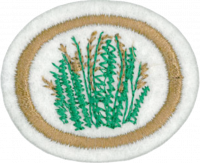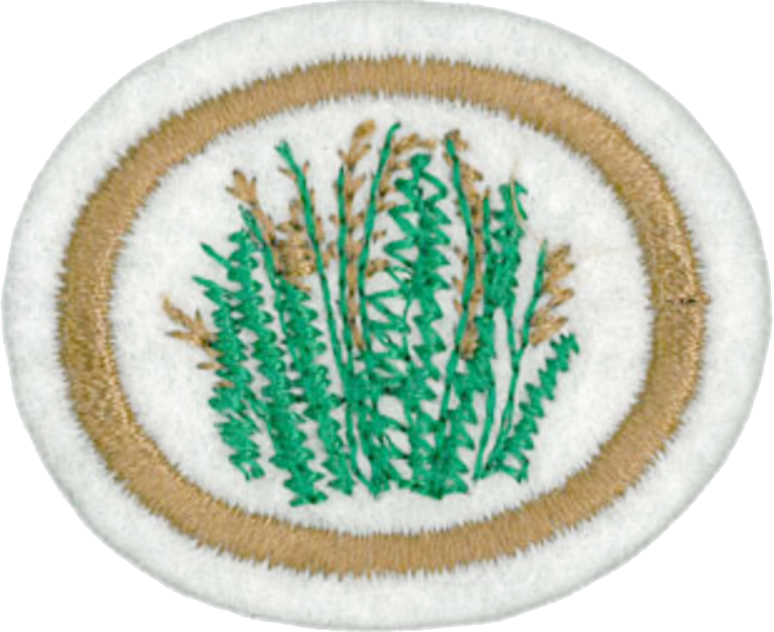Difference between revisions of "AY Honors/Grasses/Requirements"
Jomegat bot (talk | contribs) (Bot: Automated import of articles *** existing text overwritten ***) |
m |
||
| Line 1: | Line 1: | ||
{{HonorSubpage}} | {{HonorSubpage}} | ||
| − | |||
| − | |||
<section begin=Body /> | <section begin=Body /> | ||
| − | + | <b>1. <section begin=req1 /><noinclude><translate></noinclude>What characteristics must a plant have to qualify as a grass? | |
| − | <b>1. <section begin=req1 /><noinclude><translate></noinclude>What characteristics must a plant have to qualify as a grass? | ||
<noinclude></translate></noinclude><section end=req1 /></b> | <noinclude></translate></noinclude><section end=req1 /></b> | ||
| − | <b>2. <section begin=req2 /><noinclude><translate></noinclude>What kind of roots do all grasses have? | + | <b>2. <section begin=req2 /><noinclude><translate></noinclude>What kind of roots do all grasses have? |
<noinclude></translate></noinclude><section end=req2 /></b> | <noinclude></translate></noinclude><section end=req2 /></b> | ||
| − | <b>3. <section begin=req3 /><noinclude><translate></noinclude>About how many species around the world are there in the grass family called Gramineae or Poaceae? | + | <b>3. <section begin=req3 /><noinclude><translate></noinclude>About how many species around the world are there in the grass family called Gramineae or Poaceae? |
<noinclude></translate></noinclude><section end=req3 /></b> | <noinclude></translate></noinclude><section end=req3 /></b> | ||
| − | <b>4. <section begin=req4 /><noinclude><translate></noinclude>Do the seeds of grasses have two halves as does the bean (a dicotyledon), or does the seed consist of just one part as do the lily, date, and coconut (monocotyledons)? | + | <b>4. <section begin=req4 /><noinclude><translate></noinclude>Do the seeds of grasses have two halves as does the bean (a dicotyledon), or does the seed consist of just one part as do the lily, date, and coconut (monocotyledons)? |
<noinclude></translate></noinclude><section end=req4 /></b> | <noinclude></translate></noinclude><section end=req4 /></b> | ||
| − | <b>5. <section begin=req5 /><noinclude><translate></noinclude>What unique characteristic in the growth of grass leaves makes it possible for the plant to flourish even though continually mowed or grazed? | + | <b>5. <section begin=req5 /><noinclude><translate></noinclude>What unique characteristic in the growth of grass leaves makes it possible for the plant to flourish even though continually mowed or grazed? |
<noinclude></translate></noinclude><section end=req5 /></b> | <noinclude></translate></noinclude><section end=req5 /></b> | ||
| − | <b>6. <section begin=req6 /><noinclude><translate></noinclude>Name three annual grasses, that is, grasses that sprout from seeds, blossom, bear seeds, and then die the same summer. | + | <b>6. <section begin=req6 /><noinclude><translate></noinclude>Name three annual grasses, that is, grasses that sprout from seeds, blossom, bear seeds, and then die the same summer. |
<noinclude></translate></noinclude><section end=req6 /></b> | <noinclude></translate></noinclude><section end=req6 /></b> | ||
| − | <b>7. <section begin=req7 /><noinclude><translate></noinclude>Name three perennial grasses, that is, grasses whose roots live on from year to year, although the top dies down to the crown each autumn. | + | <b>7. <section begin=req7 /><noinclude><translate></noinclude>Name three perennial grasses, that is, grasses whose roots live on from year to year, although the top dies down to the crown each autumn. |
<noinclude></translate></noinclude><section end=req7 /></b> | <noinclude></translate></noinclude><section end=req7 /></b> | ||
| − | <b>8. <section begin=req8 /><noinclude><translate></noinclude>In each of the following cases name a single grass, or more where indicated, from which the product is made: | + | <b>8. <section begin=req8 /><noinclude><translate></noinclude>In each of the following cases name a single grass, or more where indicated, from which the product is made: |
<noinclude></translate></noinclude><section end=req8 /></b> | <noinclude></translate></noinclude><section end=req8 /></b> | ||
| Line 33: | Line 30: | ||
<noinclude></translate></noinclude><section end=req8a /></b> | <noinclude></translate></noinclude><section end=req8a /></b> | ||
| − | :<b>b. <section begin=req8b /><noinclude><translate></noinclude>Brooms | + | :<b>b. <section begin=req8b /><noinclude><translate></noinclude>Brooms |
<noinclude></translate></noinclude><section end=req8b /></b> | <noinclude></translate></noinclude><section end=req8b /></b> | ||
| Line 39: | Line 36: | ||
<noinclude></translate></noinclude><section end=req8c /></b> | <noinclude></translate></noinclude><section end=req8c /></b> | ||
| − | :<b>d. <section begin=req8d /><noinclude><translate></noinclude>Gluten | + | :<b>d. <section begin=req8d /><noinclude><translate></noinclude>Gluten |
<noinclude></translate></noinclude><section end=req8d /></b> | <noinclude></translate></noinclude><section end=req8d /></b> | ||
| Line 45: | Line 42: | ||
<noinclude></translate></noinclude><section end=req8e /></b> | <noinclude></translate></noinclude><section end=req8e /></b> | ||
| − | :<b>f. <section begin=req8f /><noinclude><translate></noinclude>Hay | + | :<b>f. <section begin=req8f /><noinclude><translate></noinclude>Hay |
<noinclude></translate></noinclude><section end=req8f /></b> | <noinclude></translate></noinclude><section end=req8f /></b> | ||
| Line 66: | Line 63: | ||
<noinclude></translate></noinclude><section end=req8l /></b> | <noinclude></translate></noinclude><section end=req8l /></b> | ||
| − | <b>9. <section begin=req9 /><noinclude><translate></noinclude>Do one of the following: | + | <b>9. <section begin=req9 /><noinclude><translate></noinclude>Do one of the following: |
<noinclude></translate></noinclude><section end=req9 /></b> | <noinclude></translate></noinclude><section end=req9 /></b> | ||
| − | :<b>a. <section begin=req9a /><noinclude><translate></noinclude>Collect and correctly label ten cultivated grasses. | + | :<b>a. <section begin=req9a /><noinclude><translate></noinclude>Collect and correctly label ten cultivated grasses. |
<noinclude></translate></noinclude><section end=req9a /></b> | <noinclude></translate></noinclude><section end=req9a /></b> | ||
| Line 75: | Line 72: | ||
<noinclude></translate></noinclude><section end=req9b /></b> | <noinclude></translate></noinclude><section end=req9b /></b> | ||
| − | <b>10. <section begin=req10 /><noinclude><translate></noinclude>Press or dry, mount, and correctly label the flower stalks or seed stalks of five pestiferous grasses that are commonly considered to be weeds. | + | <b>10. <section begin=req10 /><noinclude><translate></noinclude>Press or dry, mount, and correctly label the flower stalks or seed stalks of five pestiferous grasses that are commonly considered to be weeds. |
<noinclude></translate></noinclude><section end=req10 /></b> | <noinclude></translate></noinclude><section end=req10 /></b> | ||
<section begin=challenge /> | <section begin=challenge /> | ||
| − | <b>11. <section begin=req11 /><noinclude><translate></noinclude>In addition to your collection of flower or seed stalks of pestiferous kinds, press, mount, and correctly name the flower stalks or seed stalks of ten additional grasses that grow in your neighborhood. This collection may include some of the plants whose seeds are in your collection of cultivated grasses. | + | <b>11. <section begin=req11 /><noinclude><translate></noinclude>In addition to your collection of flower or seed stalks of pestiferous kinds, press, mount, and correctly name the flower stalks or seed stalks of ten additional grasses that grow in your neighborhood. This collection may include some of the plants whose seeds are in your collection of cultivated grasses. |
<noinclude></translate></noinclude><section end=req11 /></b> | <noinclude></translate></noinclude><section end=req11 /></b> | ||
<section end=challenge /> | <section end=challenge /> | ||
Revision as of 15:56, 13 April 2021
1. What characteristics must a plant have to qualify as a grass?
2. What kind of roots do all grasses have?
3. About how many species around the world are there in the grass family called Gramineae or Poaceae?
4. Do the seeds of grasses have two halves as does the bean (a dicotyledon), or does the seed consist of just one part as do the lily, date, and coconut (monocotyledons)?
5. What unique characteristic in the growth of grass leaves makes it possible for the plant to flourish even though continually mowed or grazed?
6. Name three annual grasses, that is, grasses that sprout from seeds, blossom, bear seeds, and then die the same summer.
7. Name three perennial grasses, that is, grasses whose roots live on from year to year, although the top dies down to the crown each autumn.
8. In each of the following cases name a single grass, or more where indicated, from which the product is made:
- a. Bread (three grasses)
- b. Brooms
- c. Fishing poles
- d. Gluten
- e. Grain alcohol (two grasses)
- f. Hay
- g. Hominy
- h. Molasses
- i. Oatmeal
- j. Starch
- k. Sugar
- l. White flour
9. Do one of the following:
- a. Collect and correctly label ten cultivated grasses.
- b. Write an essay on the various uses of grasses by different people around the world.
10. Press or dry, mount, and correctly label the flower stalks or seed stalks of five pestiferous grasses that are commonly considered to be weeds.
11. In addition to your collection of flower or seed stalks of pestiferous kinds, press, mount, and correctly name the flower stalks or seed stalks of ten additional grasses that grow in your neighborhood. This collection may include some of the plants whose seeds are in your collection of cultivated grasses.


